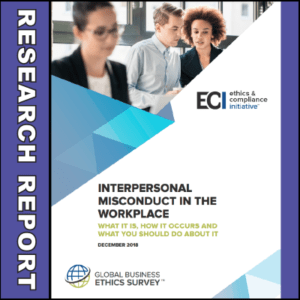A decade ago, companies made headlines for problems such as bribery, financial manipulation, and fraud. The attention has shifted, though. For the past year, mistreatment of employees, especially abusive behavior, sexual harassment and discrimination, has joined data privacy as a critical issue of our time. #MeToo and #TimesUp have given a name to the larger effort to unearth problems that have festered and to find a path towards safer more respectful workplaces. Efforts to expose the issues have uncovered repetitive patterns of interpersonal misconduct in organizations around the world. Our heightened awareness of interpersonal misconduct and the toll it takes on individual employees and organizations is a positive development. But more needs to be known about the nature of the issues, the scope of problems, the factors that exacerbate problems and strategies for fostering respectful workplaces. As part of its Global Business Ethics Survey (GBES), the Ethics & Compliance Initiative (ECI) gathered data to inform the conversations taking place in workplaces and to suggest a constructive path forward. As a result, this report provides answers to the following questions: 1. What does interpersonal misconduct (abusive behavior, sexual harassment, and/or discrimination) look like in the modern workplace? What is the frequency of these behaviors? 2. How does interpersonal misconduct occur in the workplace? What are the greatest risk factors?
A decade ago, companies made headlines for problems such as bribery, financial manipulation, and fraud. The attention has shifted, though. For the past year, mistreatment of employees, especially abusive behavior, sexual harassment and discrimination, has joined data privacy as a critical issue of our time. #MeToo and #TimesUp have given a name to the larger effort to unearth problems that have festered and to find a path towards safer more respectful workplaces. Efforts to expose the issues have uncovered repetitive patterns of interpersonal misconduct in organizations around the world.
Our heightened awareness of interpersonal misconduct and the toll it takes on individual employees and organizations is a positive development. But more needs to be known about the nature of the issues, the scope of problems, the factors that exacerbate problems and strategies for fostering respectful workplaces.
As part of its Global Business Ethics Survey (GBES), the Ethics & Compliance Initiative (ECI) gathered data to inform the conversations taking place in workplaces and to suggest a constructive path forward. As a result, this report provides answers to the following questions:
1. What does interpersonal misconduct (abusive behavior, sexual harassment, and/or discrimination) look like in the modern workplace? What is the frequency of these behaviors?
2. How does interpersonal misconduct occur in the workplace? What are the greatest risk factors?
